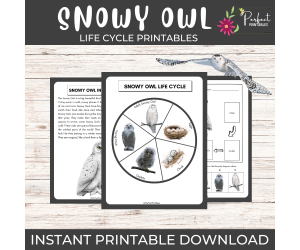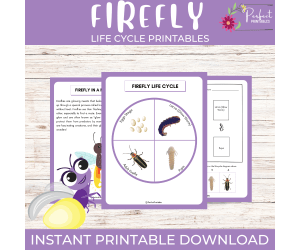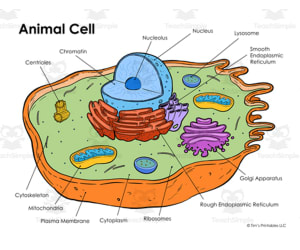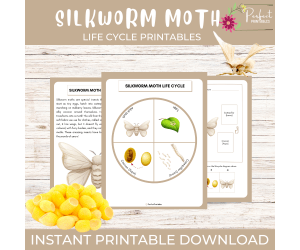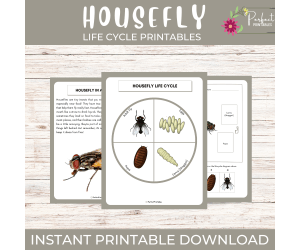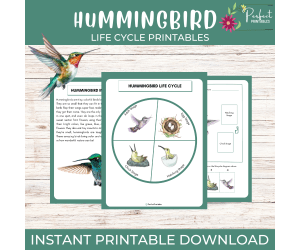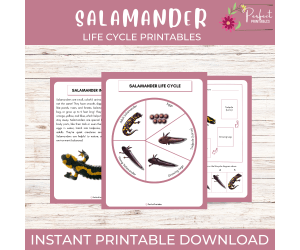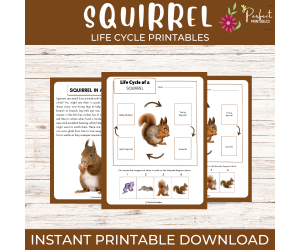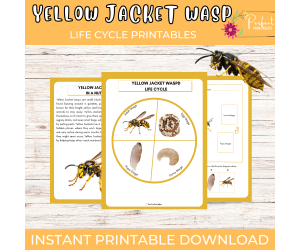2,743 products added recently
Biology: Parts of and Anatomy of
Life Cycle of a Snowy Owl Worksheet- Winter Animal Science Unit Study
Animals, Life Sciences, Science, Biology, Winter, Seasons, Holiday & Seasonal, Preschool, Kindergarten, Grade 1, 2, 3, 4, Coloring Pages, Worksheets, Worksheets & Printables, Parts of and Anatomy of, Workbooks, Projects, Activities
Introduce your students to the wonders of the Arctic with this Life Cycle of a Snowy Owl Worksheet – Winter Animal Science Unit Study . This engaging, no-prep activity is designed to help learners explore the unique life stages of the snowy owl while building key science and vocabulary skills. What’s Included In This Winter Bird Science Unit Pack? Life Cycle of the Snowy Owl diagram worksheet Cut-and-paste activity for sequencing the life cycle Snowy Owl in a nutshel Fun Facts Coloring Page Flashcard Why Teachers Love It: • Integrates seamlessly into life science and seasonal studies • Strengthens sequencing and vocabulary skills • Easy to adapt across grade levels • No prep required – just print and use Perfect For: • Winter animal and Arctic ecosystem unit studies • Bird life cycle lessons • Science centers or interactive notebooks • Homeschool, small group, or whole-class learning Bring science and nature together with this hands-on snowy owl life cycle worksheet —a fun way to explore Arctic wildlife during your winter lessons!
Author Perfect_Printables
Rating
Tags Snowy Owl Life Cycle, Winter Animal Science Unit, Life Cycle Of Snowy Owl, Arctic Bird Life Cycle, Owl Life Cycle Cut And Paste, Winter Animal Life Science, Snowy Owl Fact, Snowy Owl Adaptations, Winter Bird Life Cycle
The Plants We Eat: A Parts of a Plant Anchor Charts and Posters
Science, Life Sciences, Nature & Plants, Biology, Kindergarten, Preschool, Grade 1, Parts of and Anatomy of, Worksheets & Printables
Did you know we can eat all parts of plants. This parts of a plant anchor chart posters includes real images of fruits and vegetables for students to familiarize themselves with all the parts of a plant they can eat! This poster set includes flowers, seeds, leaves, stems, roots, and fruits. There are 6 images for each plant part. Pictures Included: Flowers: artichoke, broccoli, cauliflower, dandelion, honeysuckle, squash blossom Fruits: apple, banana, blueberry, lime, pepper, raspberry Leaves: kale, lettuce, mint, parsley, purple cabbage, spinach Roots: carrot, garlic, onion, parsnip, radish, sweet potato Seeds: almonds, beans, coconut, corn, peas, sesame seeds Stems: asparagus, bamboo shoots, celery, leek, rhubarb, scallions How to Use: These charts can be used as wall decor in a science center or as an instructional tool to teach about the plants we eat. By relating the science standard of identifying parts of a plant to foods that students commonly eat, it will ensure that students have fun and stay engaged with learning about plants! Where to Use: Wall Display in a Science Center - Place these posters on the wall of a science center while you are learning about the parts of plants. They can also be placed in a science center simply as a reference tool for students to use while completing other plant based activities. Instructional Tool - These posters make an excellent instructional tool for teachers to use to introduce to students the concept of parts of a plant in relation to the foods we eat. The real photographs in this set provide students with easy to recognize images of different edible plants. Students will love seeing all the pictures of the different kinds of plants that they can actually eat. These anchor charts and posts are no prep. The posters just need to be printed out and laminated for durability if desired.
Author The Connett Connection
Tags Plants We Eat, Parts Of A Plant
Life Cycle of a Giraffe Worksheet - Animal Science Unit Study
Montessori, Animals, Life Sciences, Science, Biology, STEM, Kindergarten, Preschool, Grade 1, 2, 3, Posters, Classroom Decor, Diagrams, Teacher Tools, Flashcards, Worksheets & Printables, Parts of and Anatomy of
Explore the fascinating world of safari animal Giraffe with our amazing "Life cycle of giraffe worksheet. Designed with young learners in mind, this engaging resource makes it easy and exciting to learn how giraffes grow, change, and live in the wild. With simple language, fun facts, and interactive activities, kids will explore the life cycle of a giraffe in a way that’s both educational and enjoyable. What’s Included in this Worksheet? Giraffe Overview: A short and engaging description of giraffes, their habitats, and what makes them special. Life Cycle Diagram: A clear and labeled chart showing the stages from calf to adult giraffe. Cut-and-Paste Activity: A hands-on way for kids to practice sequencing and reinforce their learning. Flashcards: Visual tools to help students remember each stage of the giraffe's life. Bonus Coloring Page: You will get a bonus coloring page about giraffez1 You can us this file as: Animal science units and lessons on mammals Classroom centers or independent study Homeschool wildlife and life science studies Spring or zoo-themed activities This resource is a fun mix of science, creativity, and hands-on learning—perfect for young explorers who are curious about the animal kingdom!
Author Perfect_Printables
Rating
Tags Giraffe Life Cycle, Giraffe Worksheet, Animal Science Unit, Life Cycle Printables, Homeschool Science, Biology For Kids, STEM Animal Study, Nature Study, Montessori Wildlife Unit, Savanna Animals
Life Cycle of a Peach Tree Worksheet | Plants, Botany Unit Study
Biology, Life Sciences, Science, Nature & Plants, STEM, Kindergarten, Preschool, Grade 1, 2, 3, Parts of and Anatomy of, Worksheets & Printables, Flashcards, Coloring Pages, Worksheets
Help your students explore the amazing journey of a peach tree with this fun and easy-to-follow worksheet! This Life Cycle of a Peach Tree activity is perfect for young learners who are just beginning to understand how plants grow and change over time. From a tiny seed to a tree full of juicy peaches, this resource walks kids through each stage of the peach tree life cycle in a way that’s simple, visual, and engaging. Designed with hands-on learning in mind, this worksheet encourages curiosity, critical thinking, and a love for nature and science. What’s Included In this worksheet? A clear and labeled life cycle chart of a peach tree Cut-and-paste sequencing activity for interactive learning Fun peach tree facts to build background knowledge Bonus coloring page for a creative extension This life cycle worksheet is Perfect For: Botany or plant science units Spring and seasonal science themes Gardening studies or farm-themed lessons Homeschool or classroom science centers This peach tree life cycle worksheet is a great way to mix science and fun—while helping kids build a strong understanding of plant growth and nature’s patterns!
Author Perfect_Printables
Rating
Tags Peach Tree Life Cycle, Peach Tree Worksheet, Plant Science Unit, Botany For Kids, Life Cycle Printables, Peach Tree Activities, STEM Plant Study, Nature Study Worksheets, Preschool Plant Science, Montessori Plant Unit
Life Cycle of a Cheetah Worksheet- Animal Science Unit Study
Montessori, Animals, Life Sciences, Science, Biology, STEM, Kindergarten, Preschool, Grade 1, 2, 3, Posters, Classroom Decor, Flashcards, Worksheets & Printables, Parts of and Anatomy of
Let you kids learn about the biggest wild cat with our " Life Cycle of a Cheetah Worksheet ! This engaging and kid-friendly science resource is designed to help students explore how cheetahs grow, change, and survive in the wild. With fun facts and interactive activities, learners will discover the unique life stages of the fastest land animal on Earth! What’s Included In this file? Cheetah Overview: A short and exciting introduction to cheetahs, where they live, what they eat, and what makes them special. Life Cycle Diagram: A clear, easy-to-follow chart showing each stage of a cheetah’s life—from cub to adult. Cut-and-Paste Activity: A hands-on activity that lets students cut out and sequence the stages of the cheetah’s life. Flashcards: Visual cards to help reinforce science vocabulary and life cycle steps. Bonus Coloring Page: A fun and relaxing way to review with a cheetah-themed coloring activity. This Worksheet is perfect for Animal science and wild animal units African wildlife studies Classroom centers or homeschool lessons Students who love big cats and nature What you will learn from this worksheet? Understand the stages in a cheetah’s life cycle Learn how cheetahs grow and survive in their environment Build sequencing and critical thinking skills through interactive tasks This worksheet pack is a great mix of science, fun, and creativity—perfect for helping kids connect with the wild world of cheetahs!
Author Perfect_Printables
Rating
Tags Cheetah Life Cycle, Cheetah Worksheet, Animal Science Unit, Homeschool Science, Biology For Kids, Cheetah Activities, Nature Study For Kids, Montessori Wildlife Unit, Savanna Animals, Cheetah Growth Stages
Life Cycle of a Firefly | Lightning Bug Unit Study With Fun Facts!
Montessori, Animals, Life Sciences, Science, Biology, Insects, Nature & Plants, Kindergarten, Preschool, Grade 1, 2, 3, 4, 5, Posters, Classroom Decor, Bulletin Boards, Flashcards, Worksheets & Printables, Coloring Pages, Worksheets, Parts of and Anatomy of
Have you ever watched fireflies twinkle in the night sky? These little glowing insects are truly amazing! In this fun and interactive worksheet, we will explore how fireflies grow and change throughout their lives. Get ready to learn, cut, paste, and even color! What’s Inside Your Firefly Life Cycle Worksheet? Firefly Fun Facts – Learn what makes fireflies special, where they live, and why they glow! Life Cycle Diagram – A clear and easy-to-follow chart showing each stage of a firefly’s life, from egg to adult. Cut-and-Paste Activity – Put the life cycle in order by cutting and pasting the stages in the correct sequence. Flashcards – Use these picture cards to remember the different steps in a firefly’s journey. Coloring Page – Get creative and color your very own glowing firefly! Why This Worksheet is Perfect for You! It makes learning about insects fun and exciting. You’ll get to practice sequencing skills with a hands-on activity. It helps you understand how fireflies grow and why they are important to nature. You can use your creativity with a special coloring page! What Will You Learn? The four stages of a firefly’s life—from egg to glowing adult. How and why fireflies light up at night. Why fireflies are important to the environment. How to use problem-solving and sequencing skills in a fun way! I can’t wait for you to explore the incredible world of fireflies! Let’s get started and have fun learning together.
Author Perfect_Printables
Tags Firefly Life Cycle, Life Cycle Of A Firefly, Life Cycle Printable, Life Cycle Worksheets, Bugs Life Cycle, Insect Life Cycle, Cut And Paste Activities
Life Cycle of a Pea Plant Worksheet - Plant Science Unit Study Pack
Montessori, Nature & Plants, Life Sciences, Science, Biology, STEM, Kindergarten, Preschool, Grade 1, 2, 3, Projects, Activities, Posters, Classroom Decor, Flashcards, Worksheets & Printables, Parts of and Anatomy of
Let’s learn more about amazing life of a pea plant with our worksheet! This fun and easy-to-use worksheet pack is perfect for introducing students to the stages of a plant’s growth. From tiny seed to blooming plant, kids will explore how pea plants grow, develop, and produce food. What’s You Will Get with This Study Pack? Plant Overview: A short and clear introduction to pea plants, including where they grow and why they’re important. Life Cycle Diagram: A colorful and labeled chart that shows the full journey—from seed, sprout, and seedling to mature plant. Cut-and-Paste Activity: An interactive way for students to practice sequencing the life stages. Flashcards: Helpful visual aids for remembering each part of the plant life cycle. Bonus Coloring Page: A relaxing, creative activity to reinforce learning. This Worksheet Is Ideal For: Plant science and biology units Spring-themed classroom lessons Homeschool gardening studies Hands-on centers and quiet learning activities Your Learning Goals: Identify each stage of the pea plant’s life cycle Understand how seeds grow into food-producing plants Build sequencing and observation skills through fun and interactive tasks This resource brings plant science to life and helps kids see how amazing and important plants really are!
Author Perfect_Printables
Rating
Tags Pea Plant , Life Cycle, Plant Science Unit, Life Cycle Printables, Nature Study For Kids, Botany Unit, Legume Plant Growth, Seed To Plant Stages, Science Printables, Classroom Plant Unit
Plants - Anatomy of the Flowering Plant - Middle School Science
Science, Life Sciences, Biology, Grade 6, 7, 8, 9, Parts of and Anatomy of, Worksheets & Printables
Plants - Anatomy of the Flowering Plant - Middle School Science This comprehensive teaching resource is catered to educators focused on delivering engaging and understandable science lessons. It's perfect for middle school students, offering a deep-dive into plant anatomy. Package Components: Animated PowerPoint presentation: A dynamic tool that introduces key topics in an interactive format. Helps students identify and understand the functions of different plant organs including roots, stems, leaves, and flowers. Emphasis on terms such as 'transpiration', 'guard cells', 'stomata', 'xylem', 'phloem vessels', and elements like chlorophyll,and chloroplasts. A look at the process of photosynthesis with clear illustrations of flower parts along with identification markers for ovule and pollen grain as female and male reproductive cells respectively. Worksheets: Synchronized with PowerPoint content to reinforce concepts learnt during classes or as homework assignments – adaptable depending on each group's unique needs. Worksheets come complete with answers to reduce teacher workload. Educational Assets Include: Foldable & Flip it:Innovative opportunities for learners to create personalised notes or their own questions from given answers regarded as crucial literacy development tools. Cut-and-Stick Activity: An enhancement tool aiding note-making skills. Facts are made accessible at a glance through fact sheets, while Taboo cards drive engagement. Further available tools Resources such as self-assessment checklists help track student progress.An Exit ticket quiz serves as a quick session recap tool. It’s all part of this comprehensive educational pack – designed to boost literacy and confidence in oral presentations. A suggested lesson plan is also included, featuring interchangeable resources for customised teaching approaches. To round it off, there are thirteen meticulously arranged educational tools to relief teacher's planning load. In Conclusion... 'Plants - Anatomy of the Flowering Plant - Middle School Science' breathes life into lessons by integrating scientific facts into interactive learning experiences.
Author Elf off the Shelf Resources
Tags Plant Anatomy, Flowering Plant, Biology, Interactive Learning, Science Education, Flower Anatomy Activity
Animal Cell Diagram
Science, Life Sciences, Animals, Biology, High School, Elementary, Middle School, Worksheets & Printables, Worksheets, Diagrams, Teacher Tools, Parts of and Anatomy of
A printable animal cell diagram for learning the parts of the animal cell. Perfect for elementary, middle and high school biology lessons. The parts labeled in the document include: cytoplasm, ribosomes, nucleus, nucleolus, Golgi apparatus, rough endoplasmic reticulum, smooth endoplasmic reticulum, cytoskeleton, centrioles, chromatin, mitochondria, and lysosomes. This PDF includes both the color and black and white versions of the diagram. The first two pages contain the labeled diagram. The third and fourth pages contain the blank diagram with lines for labeling. The fifth and sixth pages contain only the illustrations of the animal cell diagram to use as decoration etc. Animal Cell Diagram created by Tim van de Vall. It is copyright Tim’s Printables LLC. Terms of use: Content may be printed/downloaded for personal and educational purposes only. Commercial Use is strictly prohibited. Thank you for respecting these terms! 6 pages total. The page dimensions are: letter-sized 8.5”x11”. PDF format.
Author Tim's Printables
Rating
Tags Animal Cell, Biology, Science, Cell Parts, Prokaryotes, Worksheet, Printable, Cell, Nucleus, Golgi Bodies
Life Cycle of Arctic Fox Worksheet- Winter Animal Science Unit Study
Animals, Life Sciences, Science, Biology, Kindergarten, Preschool, Grade 1, 2, 3, 4, Coloring Pages, Worksheets, Worksheets & Printables, Workbooks, Parts of and Anatomy of
Bring science to life with this Life Cycle of the Arctic Fox Worksheet – Winter Animal Science Unit Study . This no-prep activity is a perfect addition to your seasonal science lessons, helping students explore the fascinating life cycle of the Arctic fox in a fun and engaging way. What’s Included In this Arctic Fox Unit Study? Life Cycle of the Arctic Fox diagram worksheet Cut-and-paste activity for sequencing the life cycle Arctic Fox in a Nutshell Coloring page Life cycle flashcards Fun facts Why Teachers Love It: • Supports life science, animal studies, and seasonal themes • Builds vocabulary and sequencing skills • Easy to differentiate for a variety of grade levels • No prep required – just print and go Perfect For: • Winter animal unit studies • Arctic and tundra ecosystems lessons • Science centers or interactive notebooks • Homeschool, small groups, or whole-class activities Give your students a deeper understanding of Arctic animals with this hands-on life cycle worksheet —a fun blend of science and creativity for your winter classroom!
Author Perfect_Printables
Rating
Tags Arctic Fox Life Cycle Worksheet, Winter Animal Science Unit Printable, Arctic Animals Life Cycle, Wildlife Science Worksheet, Arctic Animal Study, Life Cycle Cut And Paste, Winter Animal Classroom Worksheets, Life Cycle Science Unit, Arctic Animal
Life Cycle of a Silkworm Moth Worksheet - Insect Science Unit Study
Montessori, Animals, Life Sciences, Science, Biology, Insects, Kindergarten, Preschool, Grade 1, 2, 3, Projects, Activities, Posters, Classroom Decor, Flashcards, Worksheets & Printables, Parts of and Anatomy of
Let’s explore the amazing transformation of the silkworm moth. This Life Cycle of a Silkworm Moth Worksheet is a fun and educational way for kids to learn about insects and how they grow. This worksheet is perfect for science lessons homeschool studies and hands on classroom activities this worksheet helps students discover the full journey of a silkworm from tiny egg to flying moth What is Inside the Silkworm Moth Life Cycle Worksheet Silkworm Overview: A simple explanation of what silkworms are where they live and how they are connected to silk. Life Cycle Diagram :A clear and labeled chart showing each stage egg larva pupa and adult moth Cut and Paste Activity: A fun hands on task to help kids arrange the life stages in the correct order Flashcards : Picture cards to help remember each step of the life cycle Bonus Coloring Page You will get a silkworm coloring page with this worksheet as bonus. Why This Worksheet is Great for Kids Easy to understand and engaging for young learners Builds science knowledge and sequencing skills Encourages observation and curiosity about insects Perfect for unit studies on insects moths or the natural world What Will You Learn: The four main stages of the silkworm moth life cycle How silkworms change at each stage of growth Why silkworms are important in nature and how they help people This resource makes learning about insects fun simple and meaningful Let us discover the life of the silkworm moth together through interactive activities and fun facts
Author Perfect_Printables
Rating
Tags Silkworm Moth, Bugs Insects, Silkworm Life Cycle, Silkworm Moth Worksheet, Insect Science Unit, Life Cycle, Silkworm Activities, Insect Study, Nature Study, Metamorphosis
Life Cycle of a Woolly Bear Caterpillar Worksheet - Insect Science
Montessori, Insects, Life Sciences, Science, Biology, STEM, Kindergarten, Preschool, Grade 1, 2, 3, Posters, Classroom Decor, Flashcards, Worksheets & Printables, Parts of and Anatomy of
Let's introduce your students to the amazing transformation of the Woolly Bear Caterpillar with this fun and educational worksheet pack! Perfect for young learners, this resource helps kids explore each stage of the woolly bear’s life cycle in a simple, hands-on way. From fuzzy little caterpillar to beautiful Isabella tiger moth, this science unit makes learning about insects exciting and easy to understand. What’s Inside In This File? : Woolly Bear Overview: A short and engaging description of what makes woolly bear caterpillars special, where they live, and what they turn into. Life Cycle Diagram: A clearly labeled chart showing the stages from egg to caterpillar to chrysalis to moth. Cut-and-Paste Activity: A fun sequencing activity where kids can cut and arrange the stages of the life cycle. Flashcards: Visual learning tools to help students remember each stage. Bonus Coloring Page: A creative way to reinforce learning while coloring a woolly bear caterpillar or moth. This Worksheet is Perfect For: Insect and animal science units Fall or seasonal studies Classroom centers and homeschool lessons Nature-themed activities What your students will learn from this file? Identify the stages of a woolly bear caterpillar’s life Understand insect metamorphosis Strengthen sequencing and observation skills This worksheet is a fun mix of science and creativity that brings the life of the woolly bear caterpillar to life for curious young learners!
Author Perfect_Printables
Rating
Tags Woolly Bear Caterpillar , Life Cycle, Caterpillar Worksheet, Insect Science Unit, Life Cycle Printables, Homeschool Science, Biology For Kids, Montessori Insect Unit, Caterpillar To Moth, Insect Study
Plants - Anatomy of the flowering Plant for Middle School
Science, Life Sciences, Biology, Grade 5, 6, 7, 8, 9, Parts of and Anatomy of, Worksheets & Printables
This fully resourced lesson on the parts of a plant includes an animated PowerPoint which: > identifies the root, stem, leaves and flowers as plant organs and; > explains the functions of the root, stem, leaf and flower; > explains the terms transpiration, guard cells, stomata, xylem, phloem, chlorophyll, chloroplast and photosynthesis; > labels the parts of the flower; > identifies the ovule and pollen grain as the female and male reproductive cells. What’s Included > Animated PowerPoint for teaching with exit ticket quiz > Flip it (pupil writes questions to given answers) > Anticipation Guides (combined starter and plenary) > Foldable (students use to make their own notes) > Cut-and-stick activity pupil uses to make their own notes) > Worksheet to support the PowerPoint > Fact sheet > Homework plus answers > Fact share worksheet > 12 Taboo cards > Pupil progress self- assessment checklist > Exit Ticket > Suggested lesson plan showing choices possible between resources This pack contains 13 resources and it is intended that the teacher uses them to build their own unique lesson to take account of student ability and time available. Literacy, oracy, self- assessment and peer assessment are all built in to the resources. These features are clearly marked on the comprehensive one-page flow chart lesson plan which shows where the logical choices between resources can be made. See more Elf Off the Shelf resources on this topic and many others
Author Elf off the Shelf Resources
Tags Label The Parts Of A Flower, Function Of The Root Stem And Leaves, Xylem And Phloem Cells, Parts Of The Plant, Transpiration Guard Cells And Chloroplasts
Life Cycle of a Housefly Worksheet - Insect Science Unit Study
Montessori, Life Sciences, Science, Biology, Insects, Kindergarten, Preschool, Grade 1, 2, 3, Posters, Classroom Decor, Flashcards, Worksheets & Printables, Parts of and Anatomy of, Coloring Pages, Worksheets
Let’s take a closer look at one of the most common insects around us! This Life Cycle of a Housefly Worksheet helps students explore how a tiny fly grows and changes through its life. Perfect for science lessons insect studies and hands on activities this resource makes learning fun and easy for young learners What is Inside the Housefly Life Cycle Worksheet Housefly Overview A simple introduction to what houseflies are where they live and why they matter in nature Life Cycle Diagram A clear life cycle chart showing each stage of the housefly’s life egg larva pupa and adult Cut and Paste Activity A fun way for students to arrange the life cycle stages in the correct order Flashcards Visual tools to help kids remember each step of the fly’s life Bonus Coloring Page : You will get a housefly coloring page as bonus! Why This Worksheet is Great for Kids Easy to follow and made for young learners Supports science skills like sequencing and observation Perfect for classrooms homeschool or insect themed units What Will You Learn The four main stages of the housefly life cycle How a housefly changes at each stage Fun facts about flies and their role in the environment This simple and engaging worksheet makes science fun and helps kids better understand the world of insects Let’s learn all about the life of a housefly together
Author Perfect_Printables
Rating
Tags Housefly , Life Cycle, Worksheet, Insect Science Unit, Homeschool, Biology For Kids, Fly Activities, STEM Insect Study, Nature Study, Montessori
Life Cycle of a Dolphin Worksheet | Ocean Mammals Unit Study
Montessori, Animals, Life Sciences, Science, Biology, STEM, Kindergarten, Preschool, Grade 1, 2, 3, Bulletin Boards, Classroom Decor, Posters, Parts of and Anatomy of, Worksheets & Printables, Coloring Pages, Worksheets
Are you ready to dive into the amazing world of dolphins? This Life Cycle of a Dolphin Worksheet is a fun and interactive way to learn about how these intelligent marine mammals grow and live in the ocean. Perfect for science lessons, homeschool studies, or ocean animal units, this worksheet makes learning fun and engaging! What’s Inside in this file Dolphin Overview – Learn what makes dolphins special, where they live, and how they survive in the ocean. Life Cycle Diagram – A clear and labeled chart showing each stage of a dolphin’s life, from calf to adult. Cut-and-Paste Activity – A fun way for kids to organize and sequence the life stages of a dolphin. Flashcards – Visual tools to help students remember the steps of the life cycle. Bonus Coloring Page – A creative activity to color a dolphin while learning! This is perfect for: Helps students understand the life cycle of dolphins in a simple way. Encourages hands-on learning with interactive activities. Great for classroom science lessons, homeschooling, or marine biology units. Supports sequencing, problem-solving, and creative thinking skills. What Will You Learn? The different stages of a dolphin’s life, from baby calf to fully grown adult. How dolphins adapt to their ocean environment and why they are important. Fun facts about dolphins, including how they communicate and take care of their young. Let’s explore the amazing life cycle of dolphins together and make learning about ocean mammals exciting!
Author Perfect_Printables
Tags Dolphin Life Cycle, Dolphin Worksheet, Ocean Mammals Unit, Marine Biology For Kid, Life Cycle Printables, Homeschool Science, Biology For Kids, Dolphin Activities, STEM Marine Study, Sea Animals For Kids
Life Cycle of a Bat Worksheet - Animal Science Unit Study & Fun Facts!
Montessori, Animals, Life Sciences, Science, Biology, Kindergarten, Preschool, Grade 1, 2, 3, Flashcards, Worksheets & Printables, Coloring Pages, Worksheets, Parts of and Anatomy of
Do you want to explore the fascinating world of bats? Here this Life Cycle of a Bat Worksheet will help your students or child to learn more about this amazing mammals. This science unit is designed to help young learners understand how bats grow, change, and survive in their natural habitats. With simple explanations and hands-on activities, kids will dive into the life of one of nature’s most unique flying mammals. What’s Included In This Life Cycle Worksheet? A short Description: A short and exciting introduction to bats, where they live, and why they are important to ecosystems. Life Cycle Diagram: A clear, kid-friendly chart showing each stage—from baby bat (pup) to adult. Cut-and-Paste Activity: A fun and interactive way for students to sequence the life stages. Flashcards: Visual aids to help kids remember and review each part of the bat's life cycle. Bonus Coloring Page: You will get a free coloring page with this file! This Unit study sheet is Perfect For: Animal science or nocturnal animal units Halloween or fall-themed lessons Classroom centers and homeschool studies Encouraging curiosity about unique mammals Learning Goals: Understand the stages of a bat’s life Learn how bats live and adapt to their environments Build sequencing and observation skills through fun activities This worksheet pack is a great mix of learning and creativity—perfect for helping students discover the amazing life of bats!
Author Perfect_Printables
Rating
Tags Bat Life Cycle, Bat Worksheet, Animal Science Unit, Homeschool Science, Biology For Kids, STEM Animal Study, Nature Study , Nocturnal Animals, Bat Growth Stage, Mammals For Kids
Life Cycle of a Polar Bear | Arctic Animal Unit Study with Fun Facts!
Winter, Seasons, Holiday & Seasonal, Montessori, Geology, Earth and Environmental Sciences, Science, Animals, Life Sciences, Biology, Kindergarten, Preschool, Grade 1, 2, 3, Projects, Activities, Bulletin Boards, Classroom Decor, Posters, Flashcards, Worksheets & Printables, Parts of and Anatomy of, Coloring Pages, Worksheets
Have you ever wondered how a tiny polar bear cub grows into a strong, powerful bear? In this exciting Arctic animal unit, we will explore the incredible life cycle of a polar bear and discover how these amazing creatures survive in the icy Arctic. Get ready to learn, cut, paste, and color! What’s Inside Your Polar Bear Life Cycle Worksheet? Polar Bear Fun Facts – Learn where polar bears live, what they eat, and how they survive in freezing temperatures! Life Cycle Diagram – A simple and clear chart showing each stage of a polar bear’s life, from cub to adult. Cut-and-Paste Activity – Arrange the life cycle in order by cutting and pasting the stages correctly. Flashcards – Use these picture cards to remember the different stages of a polar bear’s journey. Bonus Coloring Page – Have fun coloring a playful polar bear in its icy home! Why This Worksheet is Perfect for You! It makes learning about polar bears fun and interactive. You’ll practice sequencing skills with a hands-on cut-and-paste activity. It helps you understand how polar bears grow and adapt to the Arctic. You can show your creativity with a special coloring page! What Will You Learn? The four stages of a polar bear’s life—from newborn cub to mighty adult. How polar bears survive in the freezing Arctic. Why polar bears are important to the environment and how we can help protect them. How to use problem-solving and sequencing skills in a fun way! Let’s dive into the icy world of polar bears and explore their incredible life cycle together!
Author Perfect_Printables
Tags Polar Bear Life Cycle, Life Cycle Of A Polar Bear, Arctic Animal Life Cycle, Life Cycle Activities, Unit Study , Bear Coloring Page, Bear Cut And Paste Activities
Life Cycle of a Venus Flytrap Worksheet- Plant Science Unit Study
Montessori, Life Sciences, Science, Biology, Nature & Plants, Kindergarten, Preschool, Grade 1, 2, 3, Posters, Classroom Decor, Flashcards, Worksheets & Printables, Parts of and Anatomy of
Let’s explore one of the most exciting plants in nature – the Venus Flytrap! This simple and fun worksheet helps students learn all about how this amazing carnivorous plant grows and survives. It’s a great way to spark curiosity and get kids excited about plant science. What’s Included in this Worksheet? A Short Overview : A short and easy-to-understand description of what makes the Venus Flytrap special and where it grows. Life Cycle Diagram: A clear chart showing each stage of the plant’s life, from seed to fully grown trap. Cut-and-Paste Activity: A fun hands-on way for students to put the life cycle stages in the correct order. Flashcards: You will get a flashcards set of All stages of life Bonus Coloring Page: A venus flytrap coloring page also included! This is Perfect For: Science lessons about plants and unique species Classroom centers or independent activities Homeschool plant studies Spring or nature-themed units What you will learn from this project? Understand each stage in the Venus Flytrap’s life cycle Learn how it catches insects and survives in its habitat Build sequencing and observation skills through interactive activities This resource is a fun mix of science and creativity—designed to make learning about the Venus Flytrap simple, exciting, and memorable for young learners.
Author Perfect_Printables
Rating
Tags Venus Flytrap , Life Cycle, Carnivorous Plant , Plant Science Unit, Life Cycle Printables, Homeschool Botany, Venus Flytrap Activities, STEM Plant Study, Nature Study For Kids, Montessori Botany Unit
Hummingbird Life Cycle Worksheet- Bird Science Unit Study
Montessori, Biology, Life Sciences, Science, Animals, STEM, Kindergarten, Preschool, Grade 1, 2, 3, Posters, Classroom Decor, Flashcards, Worksheets & Printables, Parts of and Anatomy of
Let your kids learn about most amazing and tiny bird with this " Hummingbird Life Cycle Worksheet ! Perfect for curious young learners, this science unit introduces students to the incredible journey of a hummingbird—from tiny egg to a fast-flying adult. With colorful facts and interactive activities, kids will explore how these tiny birds grow, change, and thrive in nature. What’s Included In this File? Hummingbird Overview: A simple, kid-friendly introduction to hummingbirds—where they live, what they eat, and what makes them so special. Life Cycle Diagram: A clear and easy-to-read chart that shows each stage of a hummingbird’s life, from egg to adult. Cut-and-Paste Activity: A hands-on activity that lets students cut out, organize, and sequence the stages of the life cycle. Flashcards: Visual tools that help reinforce science vocabulary and life cycle steps. Bonus Coloring Page: A relaxing and creative way for students to review while coloring a cute hummingbird. This worksheet is Perfect For: Bird and nature-themed science units Spring or garden lessons Classroom centers or homeschool learning Kids who love animals and outdoor exploration What you will learn from this worksheet? Identify and understand the life stages of a hummingbird Learn fun facts about how hummingbirds grow and survive Develop sequencing, observation, and vocabulary skills This worksheet makes science fun, simple, and exciting—just like the hummingbird itself!
Author Perfect_Printables
Rating
Tags Hummingbird Life Cycle, Hummingbird Worksheet, Bird Science Unit, Biology For Kids, Hummingbird Activities, , STEM Bird Study, Hummingbird Growth Stages
Life Cycle Of a Toad Worksheet - Animal Science Unit Study & Fun Facts
Montessori, Animals, Life Sciences, Science, Biology, STEM, Kindergarten, Preschool, Grade 1, 2, 3, Bulletin Boards, Classroom Decor, Posters, Flashcards, Worksheets & Printables, Parts of and Anatomy of, Coloring Pages, Worksheets
Have you ever seen a tiny tadpole swimming in the water? Did you know that it will one day grow legs and become a toad? In this exciting science unit, we will explore the amazing life cycle of a toad and learn fun facts about these fascinating amphibians. Get ready to learn, cut, paste, and color! What’s Inside Your Toad Life Cycle Worksheet? Toad Fun Facts – Discover where toads live, what they eat, and how they are different from frogs! Life Cycle Diagram – A simple and clear chart showing each stage of a toad’s life, from egg to adult. Cut-and-Paste Activity – Put the life cycle in the correct order by cutting and pasting the stages. Flashcards – Use these picture cards to help remember each step in a toad’s growth. Bonus Coloring Page – Have fun coloring a cute toad in its natural habitat! Why This Worksheet is Perfect for You! Makes learning about amphibians fun and interactive. Helps develop sequencing and problem-solving skills. Teaches the importance of toads in the ecosystem. Includes hands-on activities to reinforce learning. What Will You Learn? The different stages of a toad’s life—from egg to tadpole to adult toad. How toads grow, change, and adapt to life on land and in water. Why toads are important for keeping nature in balance. How to use sequencing and observation skills in a fun way! Let’s hop into learning and explore the incredible life cycle of a toad together!
Author Perfect_Printables
Tags Toad Life Cycle, Amphibian Science, Life Cycle Printables, Biology For Kids, STEM Amphibian Study, Educational Worksheets, Hands-on Science, Montessori Amphibians, , Herpetology For Kidsherpetology For Kids, Animal Life Cycles
Scorpion Life Cycle Worksheet | Animals Unit Study With Fun Facts!
Animals, Life Sciences, Science, Biology, Kindergarten, Preschool, Grade 1, 2, 3, Parts of and Anatomy of, Worksheets & Printables, Flashcards, Diagrams, Teacher Tools, Lesson Plans
Bring the fascinating world of scorpions into your classroom with this engaging Scorpion Life Cycle Worksheet . Designed for young learners, this resource introduces students to the unique stages of a scorpion’s life while encouraging curiosity about desert animals and their adaptations. This worksheet set is perfect for your animal science unit study , combining visual learning, hands-on activities, and fun facts to make lessons memorable. Students can explore the scorpion’s life cycle through diagrams, a cut-and-paste sequencing activity, matching tasks, and a coloring page to spark creativity. What’s Included In this scorpion life cycle pack? Scorpion short decsription Life Cycle Diagram Cut-and-Paste Life Cycle Sequencing Activity Matching Activity Flashcards for review Fun Facts About Scorpions Coloring Page Why Teachers Love It: No prep – just print and use Engages students with visuals and interactive activities Builds science vocabulary and sequencing skills Great for life cycle units, desert animal studies, or independent science centers Great For: Science lessons on animals and habitats Small group or independent work Early finishers and homework activities Homeschool unit studies With this Scorpion Life Cycle resource , your students will have fun exploring one of nature’s most unique creatures while strengthening their science skills!
Author Perfect_Printables
Rating
Tags Scorpion Life Cycle Worksheet, Life Cycle Of A Scorpion, Scorpion, Insect And Arachnid Life Cycle, Animal Science Worksheet, Scorpion Facts, Life Cycle Printables For Classroom, Arachnid Unit Study, Desert Animals Worksheet, Animal Life Cycle Activities
Life Cycle of a Salamander Worksheet- Amphibian Science Unit Study
Montessori, Animals, Life Sciences, Science, Biology, STEM, Kindergarten, Preschool, Grade 1, 2, 3, Posters, Classroom Decor, Bulletin Boards, Parts of and Anatomy of, Worksheets & Printables, Flashcards, Coloring Pages, Worksheets
Have you ever wondered how a salamander grows and changes throughout its life This Life Cycle of a Salamander Worksheet is a fun and interactive way to explore the fascinating transformation of these amazing amphibians Perfect for science lessons homeschool studies and hands on activities this worksheet makes learning about salamanders exciting and easy What is Inside In this Printable? Salamander Overview Learn what makes salamanders special where they live and how they survive in their habitats Life Cycle Diagram A clear and labeled chart showing each stage from egg to adult salamander Cut and Paste Activity A hands on way for kids to organize and sequence the life stages of a salamander Flashcards Visual tools to help students remember each stage of the salamanders growth Bonus Coloring Page You will get a coloring page! This worksheet is perfect for: Helps students understand the unique life cycle of amphibians Encourages hands on learning with interactive activities Great for classroom science lessons homeschooling and nature studies Builds sequencing problem solving and observational skills You will learn: The different stages of a salamanders life from egg to larva to juvenile to adult How salamanders adapt to their environment and why they are important Fun facts about salamanders including their ability to regenerate body parts Let us explore the amazing life cycle of a salamander together and make amphibian science fun
Author Perfect_Printables
Tags Salamander Life Cycle, Salamander Worksheet, Amphibian Science, Salamander Activitie, STEM Amphibian Study, Montessori Amphibians, Herpetology For Kids, Salamander Unit Stud, Wildlife Education
Life Cycle of a Squirrel Worksheet- Animal Science Unit Study
Montessori, Animals, Life Sciences, Science, Biology, STEM, Kindergarten, Preschool, Grade 1, 2, 3, Posters, Classroom Decor, Parts of and Anatomy of, Worksheets & Printables, Flashcards
Let's learn and discover the fascinating life of one of the most energetic animals in nature—the squirrel! This is a fun and interactive resource designed to help young learners understand how squirrels grow, change, and thrive in the wild. Through engaging visuals and hands-on activities, students will explore each stage of the squirrel’s life in a way that’s easy to understand and fun to follow. What’s Included In This File: Squirrel Overview: A simple and kid-friendly introduction to squirrels, their habitats, and their role in the ecosystem. Life Cycle Diagram: A clearly labeled chart showing the journey from baby squirrel (kit) to adult. Cut-and-Paste Activity: A fun sequencing task to help kids organize and remember each life stage. Flashcards: Visual aids to reinforce vocabulary and science learning. Bonus Coloring Page: A cute squirrel to color while reviewing what they’ve learned. This Project is Perfect For Animal science or forest animal units Fall-themed lessons or outdoor nature studies Homeschool, classroom centers, or early finishers Students who love animals and wildlife What You Will Learn from this worksheet? Learn the four main stages of a squirrel’s life Understand how squirrels grow and survive in their environment Practice sequencing, observation, and science vocabulary This worksheet pack combines creativity and science to make learning about squirrels exciting and memorable for kids!
Author Perfect_Printables
Rating
Tags Squirrel Life Cycle, Squirrel Worksheet, Animal Science Unit, Homeschool Science, Biology For Kids, Squirrel Activities, STEM Animal Study, Nature Study For Kids, Preschool Science, Squirrel Growth Stages
Yellow Jacket Wasp Life Cycle Worksheet- Insect Science Unit Study
Montessori, Life Sciences, Science, Insects, Biology, STEM, Kindergarten, Preschool, Grade 1, 2, 3, Posters, Classroom Decor, Parts of and Anatomy of, Worksheets & Printables, Flashcards
Let your kids learn about most amazing & buzzing world of yellow jacket wasps with this fun and educational Yellow Jacket Wasp Life Cycle Worksheet ! This insect science unit helps kids understand how these fascinating insects grow and live. With easy-to-follow diagrams, hands-on activities, and interesting facts, students will dive into the life cycle of a wasp from egg to adult. What’s Included In this file? Wasp Overview: A simple introduction to yellow jackets—where they live, how they build their nests, and what makes them unique in the insect world. Life Cycle Diagram: A clear, labeled chart showing the stages of a wasp’s life—egg, larva, pupa, and adult. Cut-and-Paste Activity: A fun way for kids to practice sequencing by cutting and organizing each life stage in order. Flashcards: Handy cards to help reinforce key vocabulary and science concepts. Bonus Coloring Page: A creative coloring sheet that keeps learning light and fun. This worksheet is Perfect For: Insect science units and nature studies Fall and outdoor-themed lessons Classroom centers or homeschool activities Kids interested in bugs and how they live What you will learn from this worksheet? Understand the four main stages in a yellow jacket wasp’s life Learn about their role in nature and how they survive Practice sequencing, observation, and vocabulary skills This worksheet is a great blend of science and fun—perfect for helping kids explore the insect world in a memorable and exciting way!
Author Perfect_Printables
Rating
Tags Yellow Jacket Life Cycle, Wasp Worksheet, Insect Science Unit, Homeschool Science, Biology For Kids, Yellow Jacket Activities, STEM Insect Study, Montessori Insect Unit, Wasp Growth Stages, Social Insects For Kids














